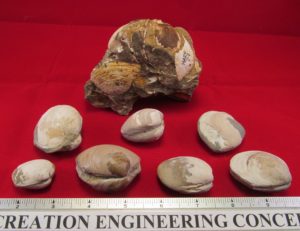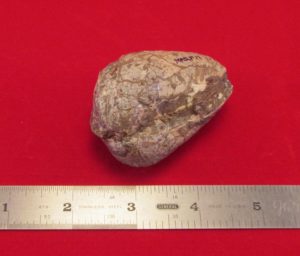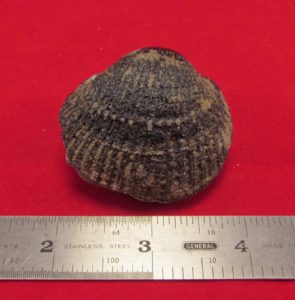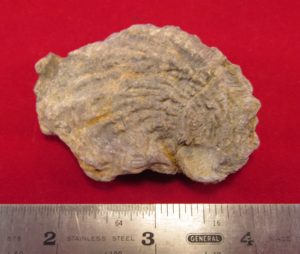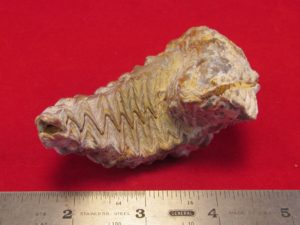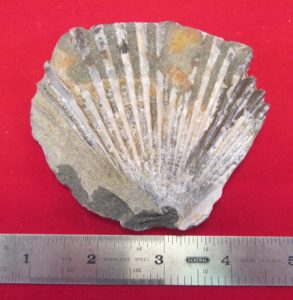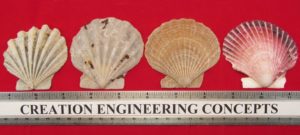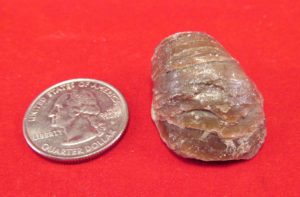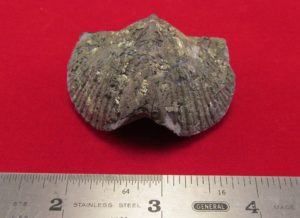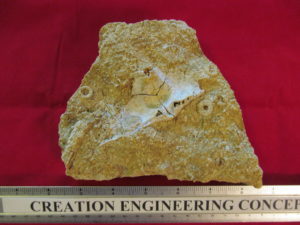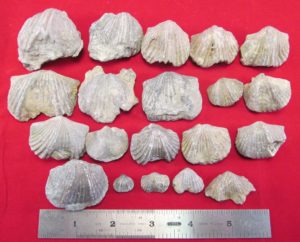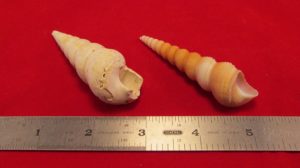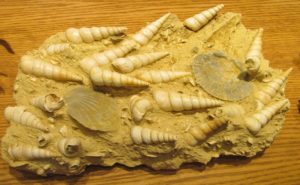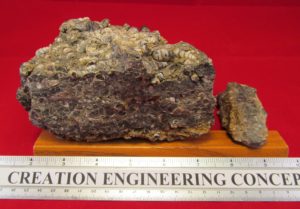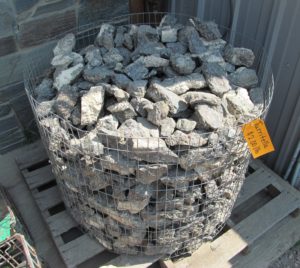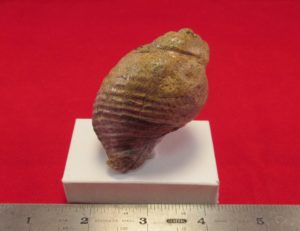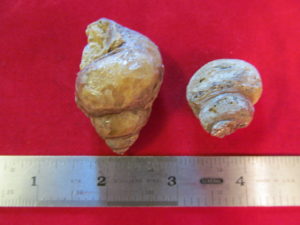All fossil images and descriptions ©2017 all rights reserved. Contact us for permission policy.
BIVALVES:
Bivalve Katherinella
Description: The conglomerate is held together by siltstone and is 5″ long X 2 1/2″ wide X 3 1/2″ high. The larger clam shells in the matrix average 1 3/4″ long X 1 1/4″ high. The seven loose fossil clams are all complete with both valves (clamshells) frozen tightly together and average about 2″ long X 1 3/4″ high. Some of the loose clams show the effects of wear from the surf prior to collection.
Location: The conglomerate is from the state of Washington. The loose fossils are from the Astoria formation near Newport, Oregon.
Interpretation: Along the Pacific Coast of Oregon at a number of locations can be found many fossil bivalve clams like these that have been eroded out of the banks. A high percentage of the Katherinella are found with their two valves shut tightly together. On the other hand, similar extant dead clams always pop apart into an open clam or even two separate valves lying on the beach. This indicates that the fossil clams must have been rapidly buried while they were still alive!
The author has noticed that many of the fossil clams from the rock record have different genus names from extant clams that look very similar. In some cases the fossil clams are so identical to living clams that they have been assigned the same genus names and are called “living fossils” by the experts because they are thought to have lived millions of years apart.
#MARF27
Bivalve Pholadomya
Description: The Pholadomya fossil clam is 2 1/2″ long X 1 5/8″ high X 1 3/4″ thick. Both valves are complete and totally permineralized with the valves clamped tightly shut.
Location: Blockley, Gloucestershire, United Kingdom.
Interpretation: This particular genus has been found in many locations throughout the world and is alive yet today, so is another example of a living fossil. The Pholadomya fossils are commonly discovered with the valves tightly closed like the specimen above, indicating rapid burial while the clam was still alive. In the rock record it can be found throughout many levels comprising the secular “Geologic Column” yet is an index fossil for specific sedimentary layers thought by evolutionists to be millions of years old. One geographical area familiar to the author where this fossil clam is found is in the central part of Oregon state.
#MARF17
Bivalve Anadara
Description: The fossil clam Anadara is 1 7/8″ wide X 1 5/8″ high. The left portion is broken away and is missing, however there is little wear or abrasion on the exterior of this fossil. Five growth rings are visible.
Location: Astoria formation near Newport, Oregon.
Interpretation: According to some sources Anadara is Oregon’s most common marine fossil. It looks very similar to cockles that inhabit our oceans today. Again, we see a bivalve that was fossilized with both valves tightly closed, indicating rapid burial while the clam was still alive – an evidence for the worldwide Flood.
#MARF79
Bivalve Cerastostreon
Description: The oyster fossil is 2″ wide X 2 1/2″ long X 3/4″ thick. There are about 12 irregular ridges on the exterior of the valve (shell) in a spread fan pattern.
Location: Walnut formation in Bell County, Texas.
Interpretation: Cerastostreon oysters are bivalve clams and have two valves that are mirror images of each other. The exteriors of the valves are so distinctive that even a novice seafood buyer can identify them.
The rock record shows that oysters have always been identifiable as oysters, but with much variation within the oyster kind. Oyster fossils are found in the rock record all over the world. Extant oysters are also very common, in part because of intentional plantings for food as humans have spread throughout the earth.
MARF72
Bivalve Lopha
Description: The fossilized Lopha oyster is 3″ end-to-end X 1 1/2″ maximum thickness. The zig-zag teeth vary from 1/8″ to 1/4″ on centers and the tooth heights vary from less than 1/8″ high to over 1/4″ high. The shell is prominently ribbed with 20 ribs on the convex (back) side and six ribs on the concave (visible) side. The valves are not equal in width.
Location: The Morondava River Basin of Madagascar.
Interpretation: The Lopha animals living and fossil show amazing design with considerable shell variation. For this reason, they have common names, such as zig-zag oyster, cockscomb oyster, and saw tooth oyster. The fossil specimen in the photo above from Madagascar is locally called a zig-zag oyster. Lopha oysters are still found alive today, thus it is a living fossil. Living Lopha are stationary suspension type feeders and filter sea water to extract nutrients. They are found mostly in tropical and subtropical ocean waters.
These Lopha oyster fossils from Madagascar are examples of where human tools (such as saw teeth and screw threads) were first invented by the Creator. The biblical creationist sees many hallmarks of design in living things that the evolutionist often misses because of his incorrect presuppositions that everything came from nothing for no reason, and animals and plants are able to invent things themselves.
#MARF86
Bivalve Pecten
Description: The scallop Pecten is 3 7/8″ wide X 3 1/4″ high X 3/4″ thick. There are 20 remaining ribs, but both ears of the valves and the hinges are missing. The valves are also damaged on the ends that open.
Location: Empire formation of Coos County, Oregon.
Interpretation: Pecten scallops are often found alive worldwide today as well as fossils in the rock record. The fossil scallop pictured above was buried rapidly when alive as shown by the fact that both valves are permanently closed tightly. That is not how scallop shells are found today on the ocean beaches. If an extant animal has died the hinge ligaments that open and close the valves always relax so that the valves will then pop open. Rapid burial by massive amounts of water-laden sediment best explains this fossil which is good evidence for the Genesis Flood.
#MARF57
Bivalve Chesapecten
Description: All four of these specimens range from 2 5/8″ to 3″ wide X 2 3/4″ to 3″ high. Fossil -1 (far left) has 11 exterior reinforcing ribs, fossil -2 has 10 ribs, fossil -3 has 15 ribs, and the recent seashell has 23 ribs. The hinges show nearly identical design for all four specimens and the amount of shell curvature is nearly the same for all.
Location: The three fossil scallops are from the Yorktown formation (James River), Virginia.
Interpretation: This photo illustrates variation within a kind. When God created the scallop kind He designed its DNA to allow for the variation seen in the photo. The three fossils are dated by evolutionists to be many millions of years old, but are really closer to 4,500 years old according to biblical creationist presuppositions.
Notice that the ribs provide strength to the shells. Every mechanical and civil engineer knows that a ribbed homogeneous plate is many times stronger in bending than one without ribs. Therefore, the DNA variation provided for scallops is not likely to allow for Pecten scallops to change to having no ribs, because to do so would result in a shell that could not withstand the external forces normally experience in its habitat.
#MARF64-1,2,3
Bivalve Gryphaea
Description: The Gryphaea fossil pelecypod is 1 1/4″ long X 1 1/16″ wide X 11/16″ thick. There are eight growth ridges visible on the exterior surface. This fossil represents half of the animal’s protective shell and is the larger left valve. The right valve fits inside the left like a lid.
Interpretation: It is easy to understand why this pelecypod bivalve animal’s shell is called the Devil’s Toenail. This specimen is somewhat smaller than those typically found. The discovery location of the fossil pictured has been lost, but Devil’s Toenails are found worldwide.
A number of fossil pelecypods similar in design to Gryphaea are known but have been assigned different genus names. This variation could have occurred during the 1,600 years from the fall to the Flood. For most creation scientists, the created kind is established at, or near, the Family level rather than the Genus level.
#MARF62
BRACHIOPODS:
Brachiopod Spirifer
Description: This beautifully formed and permineralized Spirifer fossil is 2″ wide X 1 3/8″ deep. About 16 rounded ribs are on each side of the top valve and a similar number on the bottom valve. Flakes of various sizes of pyrite are scattered over the entire surface of the brachiopod.
Location: Ohio.
Interpretation: In Genesis chapter six we read the reasons why God destroyed the entire surface of the earth with the global Flood some 4,500 years ago. Man’s wickedness and the evil of his heart resulted in the destruction of all humans and land animals except for those on Noah’s ark. In addition, the surface of the earth was greatly changed. However, in God’s grace the post-Flood earth still had many beautiful things that we can enjoy today including this wonderful Spirifer brachiopod that sparkles in the light.
Pyrite (iron sulfide) is often called “fool’s gold” because it looks so much like real gold. But people who appreciate the beauty and design of a multitude of things in the universe are not fools if they attribute them to the true Creator. Those who reject the Creator are indeed foolish and without excuse (Romans chapter one).
#MARF34
Brachiopod Spirifer (?) & Crinoid Stems
Description: In this block of stone matrix are many crinoid segments in various orientations along with a partial brachiopod that looks to be of the genus Spirifer. The fossil brachiopod would have been 4″ largest dimension in life. The matrix is 6″ wide X 5″ high X 1 3/4″ thick. Matrix failed the acid test and so is not limestone.
Location: Monroe County, Indiana
#MARF98
Brachiopod Platystrophia
Description: The five Platystrophia brachiopod fossils in the top row show the convex valve sides while the 15 in the lower three rows show the concave valve sides. All of these brachiopods are strongly ribbed with sharp-crested ribs at 16 to 20 per side. They range in size from 1/2″ wide to 2″ wide. The complete brachiopods are about two thirds as thick as they are wide. All but three of the brachiopods are fossilized with both valves tightly shut.
Location: From several locations in Kentucky.
Interpretation: These brachiopods are usually found in the lowest fossil-bearing sediments, indicating that these animals lived at the bottom of the oceans. In a manner similar to many other sea animals with opposing valves, brachiopods are often round fossilized with both valves tightly closed. This is an indication of rapid burial while the animals were still alive.
The condition of these twenty specimens is from nearly perfect shape and symmetry to quite distorted and/or broken. This can best be explained as largely due to variation within a kind and the effects of the forces on the animals from the worldwide Flood that buried them.
#MARF67
GASTROPODS:
Gastropod Archimediella
Description: Archimediella fossil is 1 1/16″ diameter on the large end X 1/8″ diameter on the small X 3 1/8″ long. There are ten whorls each having numerous cord lines with the number of lines increasing with whorl size. The aperture is broken off slightly. The Indian Auger shell to the right is 11/16″ diameter on the large end X 1/8″ diameter on the small end X 3 1/8″ long along the axis. There are 12 whorls each with cord lines similar to the fossil gastropod except the lines are more distinct. The aperture of the shell is thinner than the one in the fossil and is not broken.
Location: Unknown.
Interpretation: There are scores of these coiled gastropod varieties found not only as fossils but also found alive today in the oceans and on the beaches. If the fossil is permineralized as in the case of the Archimediella seen here it will be considerably heavier than the shell of a recent similar found on a beach.
The living examples of marine animals all have a head with eyes and a mouth along with a flattened foot for crawling. It can be assumed that the fossilized shells represent animals that were constructed similarly. These gastropods are wonderful examples of the tremendous variety within a created kind as allowed for by the information in their DNA.
#MARF43
Gastropods Turritella
Description: A mass assemblage of Turritella gastropods from France displayed at the Wyoming Dinosaur Center.
Gastropod Goniobasis
Description: Most of the encased hundreds of Goniobasis fossil gastropods are from 1/4″ to 1″ long. The chalcedony matrix exhibits three colored layers: white, gray and brown. The large block is 3″ X 3 1/2″ X 5″ and weighs three pounds. The small piece is 1″ X 1 1/4″ X 3″.
Location: Wyoming.
Interpretation: This is an example of how confusing the naming of some fossils can be. For years most rock shops have identified this conglomerate of snail fossils encased in a cryptocystalline variety of quartz as “Turritella Agate.” The reason is that the snails looks very much like the marine fossil Turritella shown above. But they are not the same as Turritella and are actually properly named Goniobasis or (according to some experts) Elimia.
Whatever the name, the fossil-stone is mined by the ton from quarries in Wyoming, Colorado and Utah and then sold by the pound. Many of these pieces are then sliced, tumbled and polished into various items of beauty such as rings and bracelets.
As with the Turritella fossils there is considerable variety within these Goniobasis snails. If these “Turritella Agate” fossilized sedimentary blocks were the result of catastrophic burial, then it would be difficult to determine if they were freshwater or marine or if they could have adapted in their various forms to both types of water.
Chalcedony is a variety of quartz, and quartz is crystalline silica which is an important material for forming both rocks and fossils. Since Goniobasis is found in numerous sedimentary layers of the rock record, that indicates that there was a lot of mixing of the habitat of these snails during the global Flood.
#OF2
Description: South Dakota rock shop container of hundreds of pounds of Goniobasis chunks identified as Turritella Agate.
Gastropod Liracassis
Description: The gastropod snail is 1 3/4″ diameter X 2 5/8″ long. Portions of the whorls are worn away and the exterior is covered in a layer of hard matrix in other places. The shell looks to have had 20 to 25 whorls prior to being buried when Liracassis was alive.
Location: Astoria formation near Newport, Oregon.
Interpretation: The Liracassis fossil gastropod looks much like the Tonna giant tun shells found today in tropical oceans. The specimen above has evidence of having been moved from its original burial location after fossilization.
#MARF80
Gastropod Vivaparus
Description: There is one complete and one partial Viviparus fossil snail with fluorescent calcite deposits attached. Large specimen is 1 1/4″ diameter X 2″ long.
Location: Deer Butte formation of Malheur County, Oregon.
#MARF99
